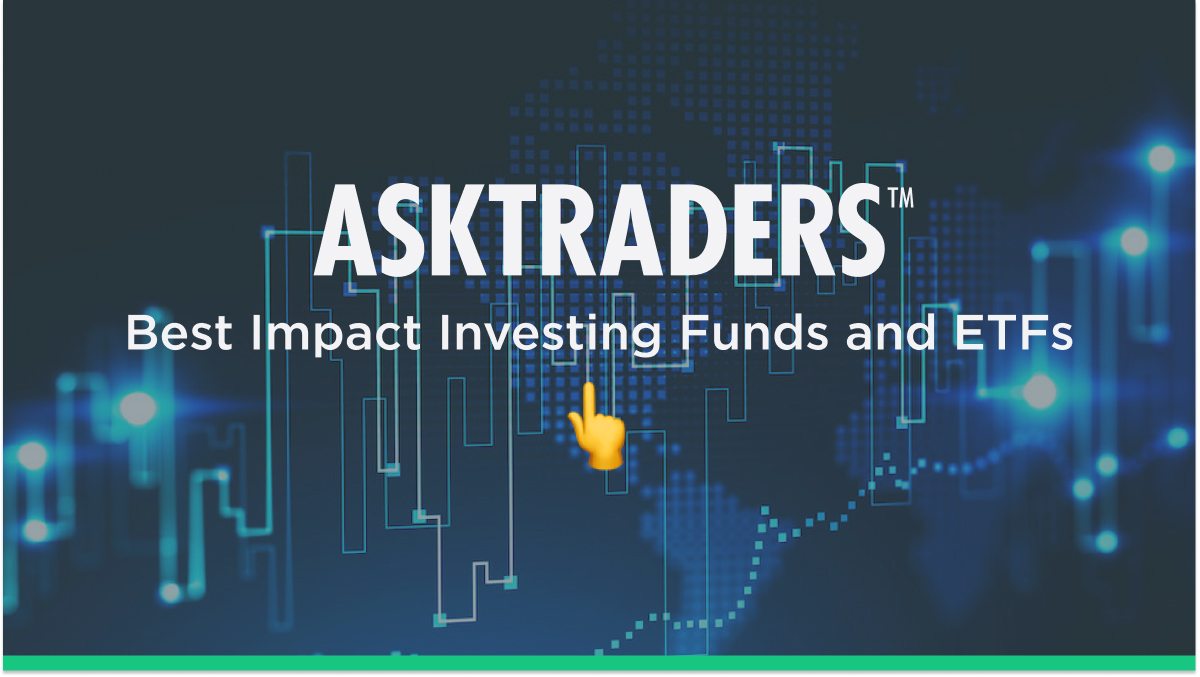Due to the ever-increasing popularity of socially conscious investing, many socially responsible impact investing funds have gained attention. These funds and ETFs (exchange-traded funds) provide ways for individuals to put their money to good use by adopting the principles of impact investing.
YOUR CAPITAL IS AT RISK

Investors can achieve diversification while owning companies that follow specific ESG criteria with these ETFs. There may be a financial return as part of the deal; however, the emphasis is on investors acting as a source of the capital needed to bring about positive societal and environmental change. The selected funds are designed to highlight the diverse ethical investment opportunities available.
Best Impact Investing Funds and ETFs to Buy Now
| Fund | Expense Ratio | Annual Dividend Yield | AUM |
|---|---|---|---|
| iShares MSCI Global Sustainable Development Goals ETF | 0.49% | 1.77% | $344m |
| Rize Environmental Impact 100 UCITS ETF | 0.55% | 0% | $89.5m |
| Invesco Solar ETF | 0.69% | 0% | $1.31bn |
| iShares Global Clean Energy ETF | 0.41% | 1.13% | $2.8bn |
| iShares ESG Screened S&P 500 ETF | 0.08% | 1.27% | $162.12m |
How We Chose the Funds
Each of these ETFs has a low expense ratio of under 0.75%. More importantly, the funds are dedicated to investing in innovative and impactful companies that promote sustainability and clean energy.
For example, the Invesco Solar ETF, as you would expect, holds a strong array of solar stocks in its portfolio, with its biggest holding being First Solar. Meanwhile, the Rize Environmental ETF invests in companies that “stand to benefit from developing and applying solutions that address the world’s most pressing climatic and environmental challenges.”
iShares MSCI Global Sustainable Development Goals ETF
The iShares MSCI Global Sustainable Development Goals ETF (NASDAQ: SDG) aims to track the performance of the MSCI ACWI Sustainable Impact Index. The index is designed to identify publicly traded companies that address at least one social and environmental challenge. The fund aims to hold companies that have leading ESG practices and focus their businesses on products and services that drive change.
| Pros | Cons |
|---|---|
| Portfolio: The companies the fund holds derive a majority of their revenue from products and services that address at least one of the world's major social and environmental challenges. | Limited Reward: While impact funds provide the benefit of investing in assets that are socially conscious, one of the downsides is that the rewards can be limited. It’s difficult to generate significant returns from impact investing, but that is not necessarily the point, with the primary goal to change societal and ecological practices. |
| Due Diligence: The fund cross-checks its impact credentials against the United Nations Sustainable Development Goal programme. |
Rize Environmental Impact 100 Ucits ETF
The Rize Environmental Impact 100 UCITS ETF invests in the 100 most innovative and impactful companies that potentially stand to benefit from creating solutions that address the world's most pressing climatic and environmental challenges.
The ETF is benchmarked to the Foxberry SMS Environmental Impact 100 USD Net Total Return Index, which is designed to track the performance of companies that are actively contributing to the development and implementation of solutions to environmental challenges.
| Pros | Cons |
|---|---|
| Exposure to innovative and impactful companies: The ETF invests in companies that are at the forefront of developing solutions to environmental challenges. | Tracking errors: ESG ETFs can have higher tracking errors than traditional ETFs, as they may have to hold more illiquid stocks in order to meet their ESG criteria. Here are the ETF's top holdings. |
Invesco Solar ETF
The Invesco Solar ETF tracks the MAC Global Solar Energy Index. The index is comprised of companies in the solar energy industry, including those involved in the manufacturing of solar panels, the development of solar projects, and the installation of solar systems. The ETF invests at least 90% of its total assets in the securities that comprise the index.
| Pros | Cons |
|---|---|
| Exposure to the solar energy industry: The ETF provides investors with exposure to a diversified basket of companies in the solar industry, helping investors potentially profit from the growth of the solar energy market. | Higher expense ratio: The Invesco Solar ETF has an expense ratio of 0.69%, which is higher than the average expense ratio for ESG ETFs. |
| Potential for long-term capital appreciation: Given that the solar energy industry is expected to grow significantly in the coming years, with governments globally investing in renewable energy sources, investors in the EZTF stand to benefit. | Sector: The solar sector is cyclical, so the ETF’s performance may experience volatility in certain periods. |
iShares Global Clean Energy ETF
The iShares Global Clean Energy ETF tracks the performance of the S&P Global Clean Energy Index. The index is composed of global equities in the clean energy sector. The ETF has exposure to companies producing energy via solar, wind and other renewable sources. Two of its top holdings include First Solar and Enphase Energy.
| Pros | Cons |
|---|---|
| Diversification: The ETF has a wide variety of stocks in its portfolio across different clean energy sectors. This should help to reduce the potential risks if one area suffers a downturn. | Geopolitical risks: Given the ETF holds various companies globally in the energy sector, it is exposed to potential geopolitical risks. For example, trade disputes between the US and China may impact companies or a sector it is heavily invested in. |
| Low Fees: The Global Clean Energy ETF has low fees, with a 0.41% management fee. As a result, it won’t cause a significant dent in your potential profits. |
iShares ESG Screened S&P 500 ETF
The iShares ESG Screened S&P 500 ETF tracks the performance of the S&P 500 Sustainability Screened Index. The index is composed of large-cap US equities. S&P Global describes the index as selecting stocks based on factors such as sustainability and impact. The ETF aims to eliminate exposure to controversial business areas. Its holdings include some of the most well-known technology names, such as Apple, Microsoft and Amazon.
| Pros | Cons |
|---|---|
| Low fees: The ETF has a significantly low 0.08% expense ratio, providing an attractive fund for investors worried about keeping fees to a minimum. | Holdings: While there is a positive to the ETF holding some of the most valuable companies in the world, some may question their ESG records. |
| Large-cap stocks: The ETF holds various well-known large-cap stocks across a variety of sectors, meaning it is well-diversified and provides an element of safety compared to just investing in newer clean energy sectors that may not have a history of strong performance. |
Why Invest in Environmentally Friendly Funds
Investors in impact investments are typically driven by two incentives, with the desire to change societal and ecological practices outweighing the need to make investment returns. With the increased interest in the sector, both factors align to make impacting investment a potential win-win.
Impact Investment Funds and ETFS and Ethical Investing
Many impact investors give priority to the need to address societal imbalances. Cash deposited by investors can be used to help smaller, greener firms develop their operations to compete with larger and less ethical corporations. Impact investing is a way to tip the scales in favour of the little guy.
Fairtrade Stocks and Investor Returns
The second reason to consider impact investing is that a groundswell of investor support for funds and ETFs can generate a financial return. Spotting and backing an established trend is the first step towards successful investing. While returns might not be the absolute priority, profits can be reinvested in other impact investment products.
What to Know Before Investing in Environmentally Friendly Funds
Impact investing funds and ETFs offer a compelling opportunity to achieve financial returns and meaningful change. However, before making the decision to invest in the sector, it's crucial to understand the nuances involved in impact investing.
Define Your Impact Goals: Most investing is about generating financial returns, but impact investing is different. It's about making a difference. Make sure to define the causes you care about to help you make informed investment decisions that align with your values.
Understand the Trade-off Spectrum: Impact investing will often involve a trade-off between financial returns and impact generation. Some funds prioritize financial performance, while others may prioritize impact, potentially sacrificing returns in the process.
Conduct Thorough Research: This point is true of any investment, but for impact investing, extra research may be required. While also evaluating the fund's financial performance, assess its transparency practices. Reputable third-party ratings can provide valuable insights into a fund's impact performance and alignment with your values.
Long-term Commitment: Impact investing is a long-term endeavour, so make sure to keep this in mind. Positive social and environmental change often takes time to materialize, so be prepared to hold your investments for the long haul and avoid chasing short-term gains.










